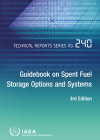Managing the spent fuel arising from nuclear power plants until its disposal is an important step of the nuclear fuel cycle and constitutes the so-called back-end. While one third of the spent fuel accumulating globally is reprocessed, most of it is stored until a decision is taken on the end-point strategy (processing or disposal).
Spent fuel management options
The nuclear fuel cycle ends with the safe, secure and sustainable management of the spent fuel, which includes its storage after withdrawal from the core of the nuclear power plant, followed by either its processing/recycling or final disposal. Safe, secure, proliferation resistant and economically efficient nuclear fuel cycles that minimize waste generation and environmental impacts globally contribute to the sustainability of nuclear energy.
The challenges are to identify and address relevant technological issues as well as to maintain a certain flexibility in the management of spent nuclear fuel to accommodate the largest range of potential options for the future.
The IAEA fosters the application of good practices and sharing of experience in spent fuel management. It provides information and guidance to its Member States, and in particular to signatory countries of the Joint Convention on the Safety of Spent Fuel Management and Radioactive Waste Management, so that they can improve their capabilities to plan, develop and implement safe, environmentally viable and efficient spent fuel management strategies.
To date the progress towards commissioning deep geological disposal facilities is slow, although a number of projects are in an advanced stage of development to meet this goal. Spent fuel storage systems may therefore have to be maintained for longer periods of time, possibly for more than 100 years, which induces research and development to be carried out and ageing management programme to be established to demonstrate the safety case of long term spent fuel storage.
A stable spent fuel management policy is thus needed for the long timeframes envisaged. This can only be achieved with the strong involvement of policymakers, governmental organizations, regulatory bodies, operators, spent fuel and radioactive waste management organizations, and the industry.
Advanced and innovative technologies are already implemented in a few countries to reprocess the spent fuel and recycle its usable materials, such as plutonium and uranium, through the fabrication and utilization of MOX fuel. Other more complex reprocessing technologies are under development in some countries to also recycle fertile (minor actinides, such as neptunium, americium and curium) and/or long-lived radionuclides (such as cesium and strontium) to make the nuclear fuel cycle more sustainable and to reduce the amount and radiotoxicity of the ultimate waste to be disposed of. These recycling technologies should support the deployment of fast reactor fuels in the long-term.








